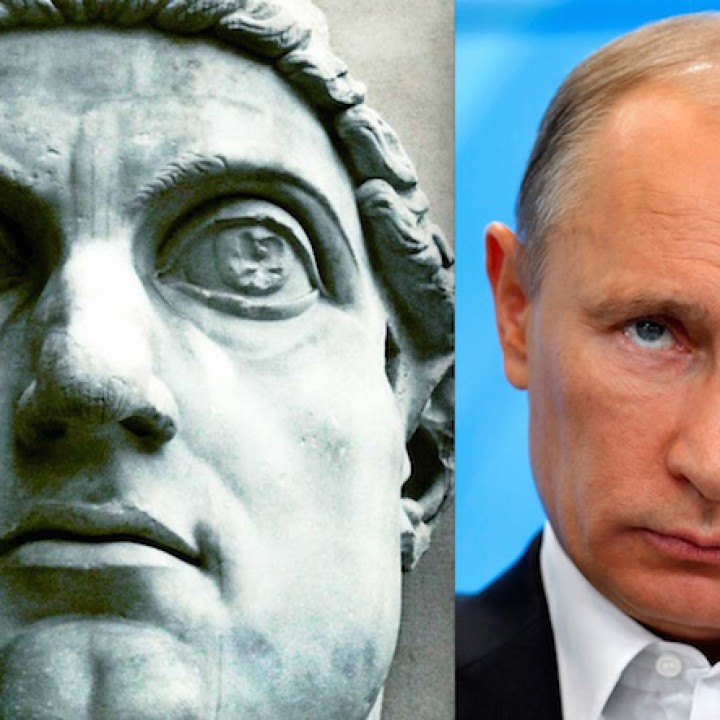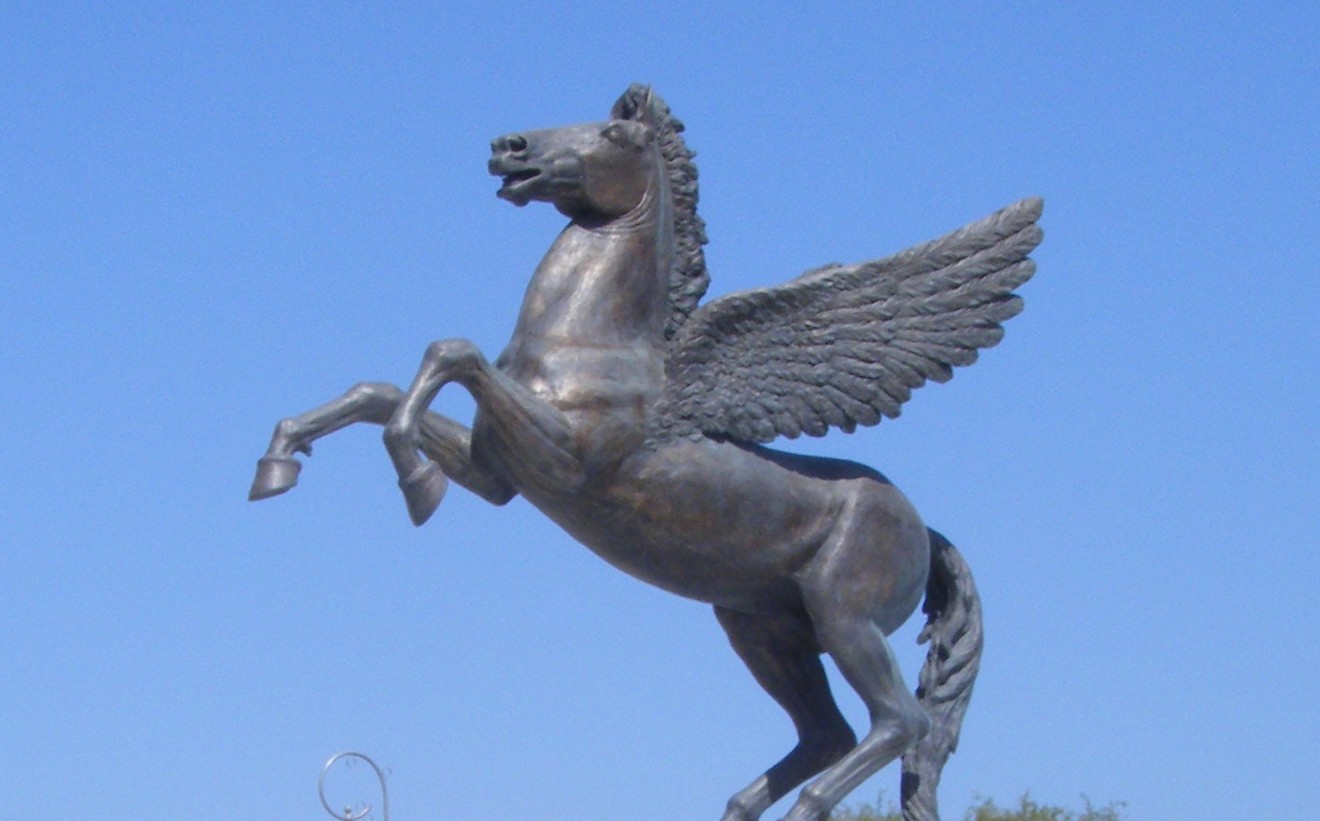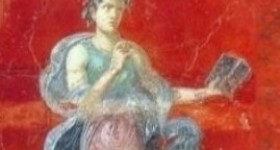What do Vladimir Putin and Constantine the Great have in common?

On the surface, there is no connection between today’s autocrat of Russia and the emperor of ancient Rome. A little bit of digging, though, reveals direct links between the two political figures; links that should not be ignored. As we are about to see, the study of classical traditions in New Russia and a comparison between the two figures is essential for the interpretation of modern politics.
As you probably know, Vladimir Putin has been acting president, president and prime minister of Russia since the fall of Boris Yeltsin in 1999. Since then he ruled over the country with an iron fist, causing both consternation and admiration in almost equal measure, depending on which side you take. During his presidency, we testified to the consistent growth of the economy and the restoration of some of Russia’s previously help political and military power. But the recovery from the collapse of Communism has not been straightforward; in fact, it was long and arduous. Putin seems to have helped turn a corner in the constant decline we witnessed during the 1970s and 1980s; and, thus, spearheaded a new era in Russian politics.
On the other hand, Constantine the Great is the celebrated emperor of the fourth century AD and Equal to the Apostles according to the Christian Church. His religious title is an acknowledgement of his outstanding services to the church as the ‘First Christian Emperor’. As for his political achievements, he will always be remember as the emperor that reunited the Roman empire and moved its capital to the little known eastern city of Byzantium, which was renamed into Constantinople. Some historians consider him the Founder of the Byzantine Empire. Similarly to Putin, he paid special emphasis to the restoration of the monetary economy and introduced the markets with the gold solidus, the coin that would be characterised as the ‘dollar of the Mediterranean’. The solidus circulated for many centuries in the regions surrounding the Corrupting Sea and empowered Roman emperors across the centuries.
Before we move towards a comparison between the two ‘emperors’, it would be interesting to explore the possibility of direct links between them. I am well aware that they ‘reigned’ almost two millennia apart from each other. And yet, a series of direct connections cannot be ignored!
The most intimate link they share is Byzantium itself. Constantinople, as the capital of the Roman empire, was seen as the “Second Rome”. The fall of Constantinople to Mehmed II of the Ottoman Empire in 1453 left a political vacuum in Eastern Europe. Ivan the III of Russia, who eventually took the title of Czar (Caesar), spotted the opportunity and jumped in it with both feet! He married Sophia Paleologos, the niece of Constantine IX, the last of the Roman emperors in order to put a claim on the Byzantine throne (whatever that may have meant at the time). By 1510, Moscow was already ‘sold’ to the public as the Third Rome. A panegyric written by the Russian monk Philotheos during that year proclaimed “Two Romes have fallen. The third stands. And there will be no fourth. No one shall replace your Christian Tsardom!” Despite the controversy, whether the Third Rome he refers to is the city of Moscow or the entirety of the Russian lands (Muscovy), the attempt to create a link to the fallen Roman empire is undeniable.

Photo: Sophia Paleolog (Palaiologos). Forensic facial reconstruction by S.Nikitin, 1994 (https://fi.m.wikipedia.org/wiki/Tiedosto:S.paleolog_reconstruction01.jpg)
Vladimir Putin is also keen to build on the pre-existing tradition. He clearly attempts to recreate the notion of the Third Rome! His propaganda machine aims at building cultural and political connections with the previous tsarist regimes as well as the Eastern Roman-Byzantine empire. I am guilty of watching several historical series produced in modern Russia that exemplify the continuation of the Roman empire into the Russian one. The most relevant I can think of is the dramatic series of Sophia, a historical drama about the aforementioned Sophia Palaiologina, the Grand Duchess of Moscow.
Another relevant manifestation of the adoption of Roman traditions, is the usage of the Roman/ Byzantine double headed eagle on the Olympic Russian team’s hockey jerseys in the Vancouver 2010 and Sochi 2014 Games ( https://thehockeynews.com/news/article/nike-unveils-jerseys-for-2018-olympics-who-will-look-best-in-pyeongchang ). The Roman emperors used the single headed eagle. The double headed one became popular in culture only after the 10th century AD, while the Byzantine emperors adopted it in their symbolic language probably the following century. The two heads symbolised the rule of the empire over East and West, an aspiration that seems to be prevalent also in Russia.
More importantly, the allusions to the Grand Tradition of the Byzantine Empire have been kept alive with the resurrection of the Russian Orthodox Church. This religious organisation, which has been persecuted under the Communist regime, now enjoys a special place in Putin’s political agenda. Putin himself played an unquestionable role in the recent religious schism between the Moscow Patriarchate and the Patriarchate of Constantinople (15 October 2018). The schism followed the decision of Constantinople to grant autocephaly (independence) to the Orthodox Church in Ukraine. At this point, I would not like to go through the minutiae of the events. Suffice to say that given the explosive political and military situation between Moscow and Kiev, the position of the Ecumenical Patriarch Bartholomew assumed unprecedented importance in Russian politics.
On 12 October 2018, Vladimir Putin, “held an operational meeting with the permanent members of the Security Council” that discussed “a wide range of domestic and foreign policy issues, including the situation around the Russian Orthodox Church in Ukraine“, according to Putin’s press secretary Dmitry Peskov. On 31 January 2019, concerning Ukraine Putin gives a hand to the Moscow Patriarchate “We have respected and will respect the independence of church affairs, especially in a neighbouring sovereign country. And yet we reserve the right to respond and do all we can to protect human rights, including the right to freedom of religion”. (Quotations and relevant references to be found in Wikipedia, “2018 Moscow – Constantinople Schism).
Similarly, Constantine the Great was rather supportive of the developments of the early Christian Church. He lent his gravitas to stabilise its formation and survival. As early as February 313 in a meeting with Licinius in Milan the state assumed a neutral position and the emperors agreed to allow all citizens to follow their faith (including Christians) without persecuting them for their beliefs. Later the emperor presided in Christian Councils in order to influence the decisions of the Church. We know that he participated actively and supported regulations that, in turn, supported his own agenda. Eusebius in his Life of Constantine III.v-x describes Constantine’s presence in the council of Nicaea:
“Constantine summoned a general synod, inviting the bishops in all parts with honorary letters to be present as soon as possible…From all the churches which had filled all Europe, Africa and Asia, those who held the chief place among the servants of God assembled at the same time…Present among the body were more than 250 bishops…After the entire synod had seated itself with seeming modesty, all at first fell silent, awaiting the coming of the emperor (Notice the building of the tension here). Soon one of those closest to the emperor, then a second and a third entered… And when the signal was given which announced the entry of the emperor, all rose, and finally he himself approached proceeding down the centre… dazzling the eyes of all with the splendour of his purple robe and sparkling with fiery rays, as it were, adorned for the occasion as he was with an extraordinary splendour of gold and jewels.” (N Lewis and M. Reinhold, Roman Civilisation, II, The Empire, pp. 580-1)

Photo: Emperor Constantine I, presenting a model of the Constantinople basilica Hagia Sophia to the Blessed Virgin Mary.
Detail of the southwestern entrance mosaic in Hagia Sophia (Istanbul, Turkey). (https://commons.wikimedia.org/wiki/File:Constantine_I_Hagia_Sophia.jpg)
Frankly, I do not expect Vladimir Putin to enter one of the Russian Church’s meeting with equal splendour. In fact, I do not expect him to enter one at all. After all, his style seems to be one that celebrates simplicity and frugality over extravagance and luxury. His wealth was estimated in 2017 to less than 150000 dollars in cash plus a modest flat in Saint Petersburg. Nevertheless, his influence is probably keenly felt and his help is probably eagerly sought out. His aim is the acquisition of power instead of wealth.
Another area, where the two emperors differ the most, is their approach to succession. Vladimir Putin has two daughters from his marriage to Lyudmila Shkrebneva but none of them seem to play a prominent role in Russian political life. His views of the restoration of Russian monarchy do not seem to include hereditary succession. On the other hand, the story of Constantine the Great makes a fascinating read. He kept a very firm grip of power by creating a solid hereditary system. After a power struggle that saw the execution of his son Crispus and his wife Fausta, the empire was eventually divided among his other three sons from Fausta, Constantine II, Constantius II and Constans.
Even though Putin and Constantine differed in dynastic politics, they were very similar in their tactics to hold on to power. As I already mentioned, Constantine the Great and Equal to the Apostles did not hesitate to execute his eldest son Crispus, and later his wife Fausta (by throwing her in overheated baths!). There are conflicting theories about the reasons behind their deaths. However, there is no doubt in my mind that they were both part of the political games of power in the Roman Empire. Similarly, in the past few years there have been several scandals, gruesome murders, and alleged suicides associated with Putin’s regime strive for power. Who can forget the spy games in the UK that saw the death of Russian spies and British civilians from poisonous materials in the city of Salisbury? It looks like absolute power can only be sustained, if an expected level of violence is inflicted; whether this happened in antiquity or the 21st century.
Of course, I do not believe that Putin tries to copy Constantine the Great! And I seriously doubt that he would insist that Russia becomes the inheritor of the Byzantine Empire. These is a tactic that the Tsars followed several centuries ago. However, there is a distinct possibility that manipulates the connection with the Eastern Roman Empire and its potent symbols for personal political gain. The gamers of power across time and space find such symbolic connections very useful.
*The image has been borrowed from this site http://shoebat.com/2015/10/01/make-no-mistake-about-it-russias-invasion-of-syria-is-a-holy-christian-crusade-done-to-protect-christianity-russia-is-truly-a-christian-nation-and-may-god-aid-her-in-the-war-against-evil-and-isl/)

